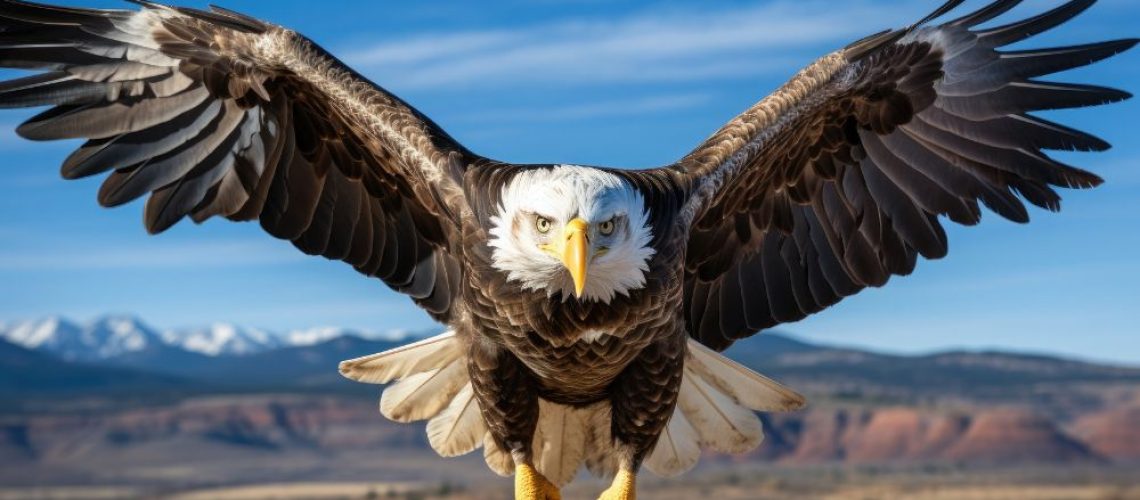Many consider the Grand Canyon a spectacle of geological color and erosional forms. But it is also a wildlife sanctuary, teeming with a diverse array of creatures. This wonder offers wildlife enthusiasts a unique opportunity to encounter and observe these remarkable species in their natural habitats. Discover what wildlife you can see at the Grand Canyon.
Bald Eagles
A bald eagle, with its striking white head and imposing wingspan, is a majestic sight to behold at the Grand Canyon. Visitors can often find these national symbols of freedom and courage on trees and cliffs when visiting the Canyon, or even see them trying to hunt trout. After you witness a bald eagle gliding gracefully against the Canyon’s dramatic backdrop, you will never forget it.
Bats
Bats have a fascinating presence in the Grand Canyon. You can spot these nimble creatures, numbering in the thousands, at dusk as they emerge from their secluded roosts searching for insects.
While they might be elusive for the casual observer, wildlife enthusiasts can detect their ultrasonic echolocation calls with the right equipment. Remember, watching these agile flyers zigzagging through the twilight skies can be an intriguing and enjoyable aspect of the Grand Canyon wildlife experience.
Bighorn Sheep
Known for their large, curved horns and agile footing, these animals can effortlessly climb and navigate the Grand Canyon’s rugged cliffs.
The late fall is a particularly interesting time for Bighorn sheep, as males engage in dramatic head-butting contests for mating rights. As always, it’s important to respect these animals by observing them from a safe distance.
California Condors
California Condors, one of the world’s largest and rarest bird species, are a significant sight at the Grand Canyon. With massive wingspans exceeding nine feet, you can often see these impressive birds soaring above the Canyon cliffs, riding the thermal updrafts.
Once on the brink of extinction during the 1980s, they have made a remarkable comeback thanks to dedicated conservation efforts. Spotting one of these magnificent birds is a privilege and a testament to successful wildlife preservation.
Coyotes
Coyotes are a captivating sight within the diverse wildlife of the Grand Canyon. These adaptable animals, which people often recognize by their lean frames, pointed ears, and bushy tails, are most active at dusk. Although primarily carnivorous, their diet is remarkably varied, encompassing everything from rodents to deer.
Coyotes have a reputation for their intelligence and resourcefulness, traits that have enabled them to thrive in the Canyon’s fluctuating conditions. Their distinctive howl, echoing hauntingly across the Canyon’s expanse at night, adds a unique and unforgettable auditory element to the wildlife experience. It is essential to admire these fascinating creatures from a safe distance and avoid any interaction that could disrupt their natural behavior.
Elk
Elks are another group of wildlife you can see at the Grand Canyon. You can easily recognize these large herbivores by their towering antlers and thick, shaggy coats. The males, known as bulls, are particularly majestic with their impressive antlers that they shed and regrow annually.
During the fall mating season, their bugling calls echo through the Canyon, adding another layer to the symphony of sounds in this natural sanctuary. Their presence in the park, grazing peacefully or traversing the terrain in herds, adds to the rich tapestry of wildlife experiences that the Grand Canyon offers to its visitors.
Falcons
Falcons, renowned for their exceptional speed and flight precision, are an exhilarating sight at the Grand Canyon. The Cayon’s cliffs provide an ideal habitat for these birds, offering ample nesting sites.
Visitors to the Canyon may be fortunate enough to witness the breathtaking spectacle of a falcon’s stoop—a high-speed dive that makes them among the fastest creatures on the planet. The sight of these masterful hunters in their natural environment marks yet another highlight in the Grand Canyon’s abundant wildlife experience.
Gray Foxes
Gray foxes are another fascinating species occupying the Grand Canyon’s diverse ecosystem. These small, nocturnal creatures distinguish themselves with their unique ability to climb trees. Their diet consists largely of small mammals, birds, insects, and plant matter.
These elusive animals are most active during the twilight hours and at night. Though sightings can be rare due to their nocturnal nature, the discovery of their distinctive tracks or hearing their raspy barks during a night hike can be an exciting moment for any wildlife enthusiast.
Mountain Lions
Mountain Lions, also known as cougars, are among the more elusive inhabitants of the Grand Canyon. These solitary and primarily nocturnal creatures possess extraordinary agility and strength.
Visitors to the Canyon should travel in groups, even though they do not view humans as their quarry. While the likelihood of a mountain lion encounter is extremely low, their secretive presence adds an element of mystery and wonder to the Grand Canyon’s diverse wildlife tableau.
Mule Deer
Travelers can also spot mule deer during their trips to the Grand Canyon. Known for having ears like mules, visitors can usually see these graceful creatures at dawn or dusk when they are most active. Their diet mainly consists of vegetation, including shrubs, forbs, and grasses, and you can often see them grazing peacefully.
Visitors should refrain from feeding them to ensure they remain healthy and wild. Catching a glimpse of a mule deer, with its characteristic bounding leap, is a moment of delight for any wildlife watcher.
Ringtails
Ringtails, often referred to as “miner’s cats,” are another intriguing and lesser-known resident of the Grand Canyon environment. These small mammals feature long, bushy, white-striped tails and are adept climbers. You can often find them in rocky, cliffside habitats.
Although they are primarily nocturnal, the sound of their high-pitched calls may offer signs of their presence to the observant visitor. Despite their elusive nature, a rare sighting of a ringtail, often while they’re hunting insects, small mammals, or scavenging for fruits, can add an extra thrill to a wildlife spotting adventure in the Grand Canyon.
The presence of these animals shows that the Grand Canyon offers far more than breathtaking views and geological wonders. Comedy on Deck Tours allows you to see all these marvels when you take its Grand Canyon Comedy Tour. We also provide a complimentary lunch on the Grand Canyon Rim and the opportunity to take a photo at the Hoover Dam Bypass Bridge.



